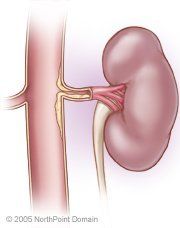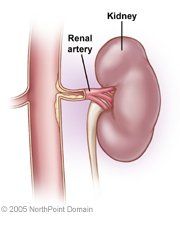Renal Artery Disease
Basic Facts
- Renal artery disease is a component of peripheral arterial disease (PAD). Arteries carry blood away from the heart to the head, torso, arms, and legs.
- Renal artery disease occurs when an artery leading to one or both of the kidneys becomes blocked, which can prevent blood from reaching the kidney.
- Symptoms of renal artery disease include high blood pressure, known as renal vascular hypertension. Severe renal artery disease may lead to kidney failure.
Renal artery disease is a condition in which an artery leading to one or both of the kidneys becomes blocked. This disease occurs mostly in men between the ages of 50 and 70. Most of the time, the disease affects the arteries leading to one of the kidneys. But in about one-third of the cases, the arteries leading to both kidneys are affected. Left untreated, it can cause permanent kidney damage.

WHAT ARE THE SYMPTOMS?
In the early stages of renal artery disease, there may be no symptoms.
When symptoms do occur, they can include kidney failure and bruits, abnormal sounds or murmurs as blood flows through blood vessels.

CAUSES AND RISK FACTORS
In people with renal artery disease who are more than 50 years old, the disease is usually caused by atherosclerosis, or hardening of the arteries. In patients younger than 30, especially women, the disease is usually caused by a congenital muscle disorder called fibromuscular dysplasia.
Several factors increase the risk for renal artery disease, including:
- Family history of renal artery disease;
- Age;
- Diabetes mellitus;
- Gout;
- Hypertension (high blood pressure);
- Peripheral artery disease (PAD), especially lower extremity disease;
- Obesity;
- Cigarette smoking;
- Lack of exercise;
- Diet high in saturated fats; and
- Excessive alcohol consumption.
DIAGNOSIS
Because there may be no symptoms in the early stages of renal artery disease, it can be difficult to diagnose. The physician will take a detailed medical history, and may listen to the arteries near the kidneys with a stethoscope.
The physician may also order tests to confirm the diagnosis, including:
- Captopril renal scan;
- Duplex ultrasound;
- Magnetic resonance angiography (MRA); and
- Angiography.
TREATMENT APPROACH
The physician may recommend lifestyle alterations to treat renal artery disease, including:
- Losing excess weight;
- Quitting smoking;
- Exercising regularly;
- Decreasing fat in the diet; and
- Limiting alcohol consumption.
In addition, the physician may prescribe antihypertensive medications to lower blood pressure. Antihypertensive drugs that the physician may prescribe include:
- Angiotensin converting enzyme (ACE) inhibitors;
- Calcium channel blockers;
- Beta-blockers; and
- Diuretics.
In some patients, ACE inhibitors may cause kidney function to deteriorate.
If lifestyle changes and medication are ineffective, the physician may also recommend surgery or minimally invasive procedures, including:
- Angioplasty;
- Endarterectomy; and
- Renal artery bypass surgery.
Copyright © 2017 NorthPoint Domain, Inc. All rights reserved.
This material cannot be reproduced in digital or printed form without the express consent of NorthPoint Domain, Inc. Unauthorized copying or distribution of NorthPoint Domain's Content is an infringement of the copyright holder's rights.
